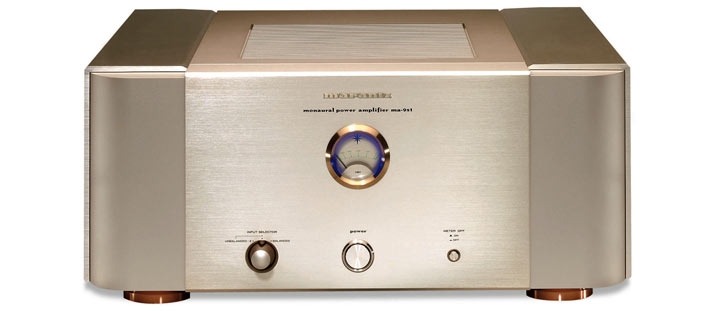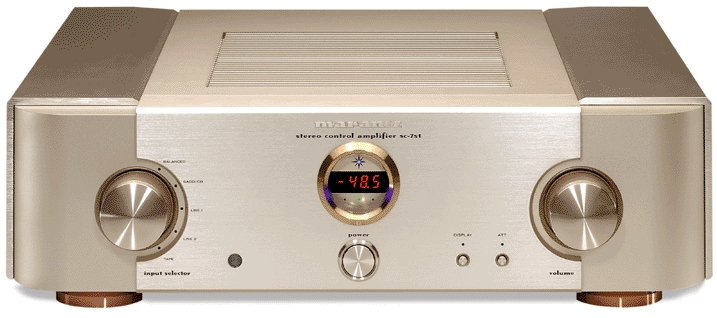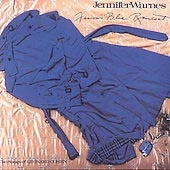Marantz SC-7S1 Preamplifier & MA-9S1 Mono Amplifier
| Marantz SC-7S1 Preamplifier & MA-9S1 Mono Amplifier |
| A Return To The Days Of The Marantz Models 7 & 9? – NOT QUITE! |
|
|
|
January 2007 |

Back in the days when I was a young music lover and a budding audiophile, the biggest names in audio were Marantz and McIntosh – tubes, not solid state. I would have given anything for a Marantz amp, but my bank account wasn’t big enough. Let’s face it, it’s difficult to be an audiophile when you’re young – just too many wonderful and exciting (and expensive) high-end audio products. I did own a McIntosh preamp for a short time, followed by a succession of electronics including a Heathkit, a Fairchild 50 watt (wow!) amp, and Quad Series II amps (that I still own). Marantz and McIntosh are still around, and both under the same Japanese corporate banner.
Saul Marantz introduced the Model 7 Stereo Preamplifier in 1958 and the Model 9 Amplifier (in my estimation, his most coveted product) in 1961. Before the advent of the RIAA LP equalization standard, there were several analog disc formats. The Model 7 accommodated all those available, enabling the music lover to precisely equalize (or come damn close to) the frequency response of the chosen LP. The Model 9 monoblock amp had an RMS output of 70 watts, 40 watts in triode configuration, utilizing EL34 output tubes, and weighed in at nearly 60 lbs. – at that time, a brute of an amp. Both of these analog products were nearly revolutionary in those early years of stereo reproduction – every internal component was very carefully chosen to provide the best sound possible. This was not a common design philosophy for home audio products in those days.
Now, more than forty years later, Marantz has chosen to celebrate the “rebirth” of the Models 7 and 9 with an all out, solid state assault in the reproduction of music with the design and execution of the SC-7S1 and the MA-9S1 (products in their heralded Reference Series). Marantz has retained the distinctive meters of the original Models 7 and 9 in their new offerings. Today, there are a number of innovative engineering attempts by other high-end manufacturers of preamps and amplifiers to create the end-all in design with little concern for cost. So, with that in mind, the Marantz Reference Series must be judged against the other contenders.
FEATURES AND SPECS
Both the 7S1 and 9S1 look and feel impressive, about 45 lbs. and 80 lbs. respectively – very much the mates of the SA-11S1, SACD/CD Player, and finished in the same satin gold tone. The similarity doesn’t end there: the chassis reveals the heavy copper plated steel that shields circuits from RF and provides, together with a non-magnetic solid extruded aluminum case, a very stable, resonance-free enclosure; removing the covers discloses carefully selected internal components including the custom built, toroidal power transformer, choke input power supply and high quality, audio grade parts; and solid copper, precision machined feet.

…The SC-7S1 Preamp
Since the SC-7S1 does not provide an internal phono equalization module, it would be more correct to label it a “Stereo Line Stage Control Amplifier”, and, in fact, Marantz does refer to it as the “control amplifier”. The front panel sports a power switch, meter, attenuation and display buttons, and two large silky, smooth knobs – input selector and volume control. The rear panel provides a pair of balanced inputs and balanced outputs. The remaining inputs and outputs are unbalanced. The lack of additional balanced inputs initially left me both surprised and disappointed, particularly considering the price! But, frankly, some rather careful listening to SACD through balanced and unbalanced inputs was, surprisingly, exactly the same, including the lack of any perceived background noise. I attribute this to Marantz’s design of a “fully balanced control amp”. A review of the specs indicated that all of the voltages, etc., for balanced and unbalanced, again, are exactly the same! Additionally, the rear panel includes an AC in socket, and remote control in/out connectors, ID NO. switch and mode switch – these last three allow for multiple SC-7S1s to connect to one another for Bi-Amp capability and flexibility beyond anything else with which I’m familiar.
Among other impressive design features are: an eight gang, linear volume control with adjustment range from 100-0dB in 0.5dB steps; multiple, new HDAM SA – High Definition Amplifier Modules – to improve the ultra-wide frequency response to 150kHz; channel separation of over 100dB at 20kHz; minimum feedback impedance; a choke input system to reduce rectifier harmonic noise to a minimum, and provide a very high signal to noise ratio; a floating control bus system to control up to six control amps; and an impressive metal remote control that includes additional detailed adjustments.
…The MA-9S1 Amplifier
According to Marantz, the overriding design concept of the Class A/B monoblock amplifier is to create a power supply that provides “instantaneous current delivery capability…three times as much compared to any Marantz product designed before”. To aid in the success of this concept is a fully balanced circuit in a push-pull construction, the addition of the new, multiple High Definition Amplifier Modules, the choke input system, and a capacitance input system for ultra low impedance. Two 220,000uF capacitors are used to filter the amp power supply. Marantz notes than the solid state output devices are “…multi-emitter type bipolar transistor[s] called LAPT made by SANKEN…[which have]…ten times faster response speed than ordinary transistor[s].” The protection system switches “…the speaker output relay by sensing the output current, DC and power transistor temperatures.” Again, the sensitivity, 1.7 volts, is the same for balanced and unbalanced inputs.
The front panel includes an on/off switch, an input selector to choose between balanced or unbalanced source, the afore-mentioned level meter showing output power in decibels, and an on/off switch for the level meter.
The rear panel features balanced and unbalanced inputs, dual speaker output terminals for bi-wiring, an AC in socket, and a switch to attenuate the input level. The attenuator, not commonly found on amplifiers, I consider an increasingly essential device, particularly to match the sensitivity between an amp and preamp from different manufacturers.
SOUND REASONS
Again, let me review my listening venue: “My living room is about 24’ x 16’ with a cathedral ceiling about 9’ high in the center, sloping to about 5’10” at either end. My Piega P10 Reference loudspeakers are about 8’ from the rear wall and nearly 10’ apart measured from the center of the speakers. My far-field listening position is almost 14’ away….The speakers are angled in and cross just in front of where I sit. Although I didn’t consciously follow the 1/3 rule-of-thumb in set-up, that’s where the speakers sound the best.” For this review, nearly all of my listening was in the near-field in order to get a bead on the precise capability of the Marantz SC-7S1 Stereo Preamp & MA-9S1 Mono Amps.
Over the many months that the Marantz duo was in my system, I listened to a substantial part of my collection of CDs, SACDs, and LPs. Only a few of the titles are represented here. For two days after the lengthy Marantz listening session, I returned to my own tube reference system and listened to the same few titles. Believe me, that was quite an interesting experience; it placed the differences between excellent all tube amplification and excellent all solid state amplification in some contrast. Where in the past, I have been a strong advocate of the superiority of the finest tube amplification, I have come to realize that the best solid state, as represented by the Marantz, is a more than credible alternative. I’m not suggesting that one is better than the other, but that the approach and emphasis of each is slightly different and equally valid.
 The first recording is from the 2005 Chesky Records Sampler. Track three, “Stepping”, is from Circle of Drums(Chesky SACD 295), featuring Babtunde Olatunji. The depth and timber of the drums are palpable – the stretched surface clearly evident. Transients are superb, the location of each instrument precisely placed across the soundstage, providing nearly live reproduction. The mid-bass at the beginning of “Unbreak My Heart”, track one from Il Divo [Syco 8287 667654] is quite prominent, but correct. The lower register and mid-range of the male voices is very smooth and beautifully reproduced. In the accompaniment, the guitar overtones are clearly evident.
The first recording is from the 2005 Chesky Records Sampler. Track three, “Stepping”, is from Circle of Drums(Chesky SACD 295), featuring Babtunde Olatunji. The depth and timber of the drums are palpable – the stretched surface clearly evident. Transients are superb, the location of each instrument precisely placed across the soundstage, providing nearly live reproduction. The mid-bass at the beginning of “Unbreak My Heart”, track one from Il Divo [Syco 8287 667654] is quite prominent, but correct. The lower register and mid-range of the male voices is very smooth and beautifully reproduced. In the accompaniment, the guitar overtones are clearly evident.

 It begins with the melodious voice of Pavarotti in his prime, and ends with one of the loudest crescendos of any CD in my collection. During the last couple of minutes, the meter hovered between -18dB and -12dB (-0dB represents full power). Yet, there was no indication of clipping or any indication that the Model 9 would run out of power. I have heard the singers at the Met in New York on many occasions. The amp’s ability to reproduce voices accurately is extraordinary. The lower register of male voices, and the mid-range of Caballe’s soprano was right on. If I had to pick one recording of the hundreds of CDs and LPs I have listened to over these many months, this one would surely represent the balanced, neutral, wide and deep soundstage of which this amp is capable. The dynamics were outstanding – with reserve power of up to 600 watts at 4 ohms, this should be the case.
It begins with the melodious voice of Pavarotti in his prime, and ends with one of the loudest crescendos of any CD in my collection. During the last couple of minutes, the meter hovered between -18dB and -12dB (-0dB represents full power). Yet, there was no indication of clipping or any indication that the Model 9 would run out of power. I have heard the singers at the Met in New York on many occasions. The amp’s ability to reproduce voices accurately is extraordinary. The lower register of male voices, and the mid-range of Caballe’s soprano was right on. If I had to pick one recording of the hundreds of CDs and LPs I have listened to over these many months, this one would surely represent the balanced, neutral, wide and deep soundstage of which this amp is capable. The dynamics were outstanding – with reserve power of up to 600 watts at 4 ohms, this should be the case.
SUMMING UP
If Saul Marantz were around today, I think he would agree that the new Marantz Reference Series solid state duo has kept the promise of the original Models 7 and 9 with a design that leaves nothing to chance in creating an excellent stereo preamp and outstanding monoblock amplifiers that take their place, in my experience, among the very finest in analog amplification available today. I cannot fault the 7S1 and 9S1 in any area.
Together, they present what is probably the most neutral, smooth and balanced reproduction I have yet heard – no part of the sound spectrum is emphasized or left wanting. While (listening in the near-field) my reference tube amp and preamp are slightly forward, the Marantz are very slightly laid back; of course, this is so dependent on your speakers and the nature of your room acoustics. When I replaced the Marantz preamp with the Aesthetix Calypso, the 9S1 took on somewhat of the character of the Calypso, an example of how neutral the amps are. The soundstage is both wide and deep, with each instrument and voice precisely placed – the speakers virtually disappearing. Transients and dynamics left nothing to be desired. Never once did the amps clip or run out of power – Marantz’ claim of “instantaneous current delivery…” is entirely borne out. Detail throughout the range is exceptional. Authority and control is beyond reproach. It was a sad day when I parted with the 7S1 and 9S1s.
If you are considering a new preamp and amplifiers, and the price is within your budget, I strongly urge you to listen to the to Marantz’s Reference Series, 7 and 9. Very, highly recommended.
According to Marantz, shortly they will be releasing upgraded versions of the Models 7 and 9, most of the changes will be with the preamp.
Lewis Lanese
____________________
Specifications:
SC-7S1 Reference Series Stereo Preamplifier
Price, $7,500.00
Maximum output voltage (20Hz-20kHz) …. 13.5V (BALANCED) 13.5V (UNBALANCED)
Total harmonic distortion (20Hz-20kHz)0.0015% (BALANCED) 0.003% (UNBALANCED)
Frequency response (+0/-3dB) …….. 3Hz–150kHz (BALANCED) 3Hz–150kHz (UNBALANCED)
Input sensitivity/Input impedance ………….. 420mV/20k (BALANCED) (UNBALANCED)
Output impedance ………………………………………….220 (BALANCED) (UNBALANCED)
S/N (IHF-A) …………………………………………………. 103dB (BALANCED) 105dB (UNBALANCED)
Channel separation (20kHz) …………………………… 100dB (BALANCED) (UNBALANCED)
Volume adjustment range ……………………. -∞, -100–0dB (0.5dB STEP)
Trim level adjustment range …………………………….. ±6dB (0.5dB STEP)
Attenuator setting level …………………………………… -20, -40, -60, -∞dB
Supply voltage ………………………………. AC 120 V 60Hz
Power consumption …………………………. 22W (0.2 A)
Dimensions ………….. W 459mm, H 136mm, D 441mm
Weight …………………………………………………… 21kg
MA-9S1 Reference Series Monaural Power Amplifier
Price, $7,500.00
Power Output (20Hz – 20kHz) …………………………… 300W (8 Load) 600W (4 Load)
T.H.D. (20Hz – 20kHz, 8 Load) ……………………………………… 0.01%
Frequency response (1W, 8 Load) …………………….. 3 Hz – 120 kHz (+0, –3dB)
Damping factor …………………………………………………………………. 200 (20Hz – 20kHz, 8 Load)
Input sensitivity/ Input impedance …………… 1.7V / 20k (Balanced) 1.7V / 20k (Unbalanced)
S/N (IHF-A) …………………………………………………. 120 dB (Balanced) 120 dB (Unbalanced)
Attenuation ………………………………………… 0, –3, –6, –9, –12, – ∞ dB
Power requirement …………………………………………………….AC 120V 60Hz
Power Consumption …………………………………. 500 W (5.8 A)
1200 W (Output: 4, 600W)
Dimensions ……………… Width 459 mm, Height 198 mm, Depth 451 mm
Weight ……………………………………………………………………….. 35.8 kg
Marantz America, Inc
100 Corporate Drive
Mahwah, NJ 07430
Phone:201-762-6553
http://www.marantz.com
![]()
Don’t forget to bookmark us! (CTRL-SHFT-D)
Stereo Times Masthead
Publisher/Founder
Clement Perry
Editor
Dave Thomas
Senior Editors
Frank Alles, Mike Girardi, Russell Lichter, Terry London, Moreno Mitchell, Paul Szabady, Bill Wells, Mike Wright, and Stephen Yan,
Current Contributors
David Abramson, Tim Barrall, Dave Allison, Ron Cook, Lewis Dardick, John Hoffman, Dan Secula, Don Shaulis, Greg Simmons, Eric Teh, Greg Voth, Richard Willie, Ed Van Winkle, Rob Dockery, Richard Doran, and Daveed Turek
Site Management Clement Perry
Ad Designer: Martin Perry





Be the first to comment on: Marantz SC-7S1 Preamplifier & MA-9S1 Mono Amplifier